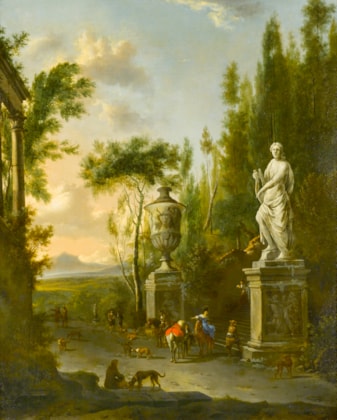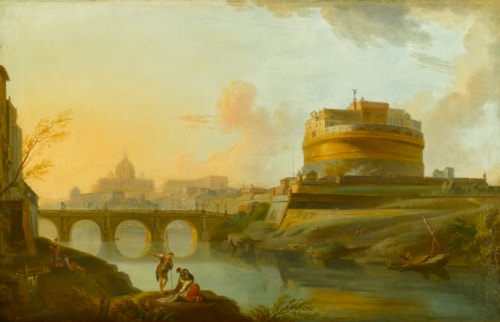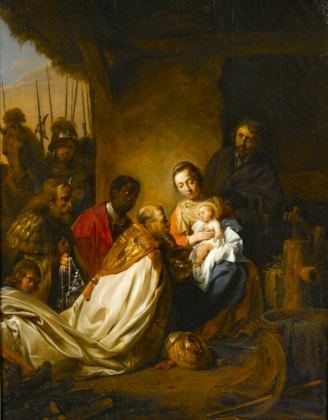draen Frans Boudewijns
(Brussels 1664 - Brussels 1711)
An Extensive River Landscape with Figures around a Village with a Town in the Distance & An Extensive Mountainous Landscape with Figures before a Building
the first signed ‘F. Bauduin’ (lower left); the second signed ‘F. Bauduin’ (lower centre)
oil on canvas, a pair
each 51.4 x 63.2 cm (20¼ x 25 in) (2)
Set against a dramatic backdrop of undulating mountain scenery and peopled with brightly lit figures, this pair of paintings presents an exquisite example of the Flemish landscape genre. In An Extensive River Landscape with Figures around a Village with a Town in the Distance, a group of figures in the foreground stop to converse on a well-travelled road. Beyond them, two people make their way along the path leading towards a lake, where more figures and two horses are faintly identifiable. Near the lake, the edge of a town can be seen and in the centre of the painting, a building is nestled within the landscape in front of which stand a herd of cows and a farmer. To their right, a river meanders its way through the craggy landscape where further buildings are situated.
In An Extensive Mountainous Landscape with Figures before a Building, a horseman passes a man talking to two women, one of whom sits down to rest; nearby a child clad in blue and a loyal dog wait patiently. Beyond them, two figures follow the path as it curves round to a bridge over which a herdsman guides his cattle. Further along the path still, three more figures can be seen approaching a town. Through the trees on the right hand side of the painting another town sits on the water’s edge and in the distant haze, the faint silhouettes of two sailing boats can be glimpsed.
The warm light, grand illusion of space and quiet activities of the villagers combine to set the tone of both paintings: Their idealistic rendering lends them a theatrical quality. A soft, golden light suffuses the works, filtering through trees and defining the features of the land and the majestic mountains of the distance. In these atmospheric landscapes, rural life operates harmoniously and at a leisurely pace.
Adriaen Frans Boudewijns’s successful realisation of space and perspective is achieved through considered structuring of the composition and painterly techniques. The winding paths of both paintings naturally lead the eye towards their horizons. The bold foreground elements, notably the trees which frame a side of each painting, provide perspective as they contrast with the statuesque yet distant landmarks of the background. The details seen in the objects of the foreground, from the people to the dappled foliage, logically diminish in the objects of the background as they are lost in a hazy mist. A similarly skilful use of light, employing bolder colour and heavier shading in the foreground, which fades as the painting recedes, enhances this sense of depth.
The detailed figures that occupy the paintings are superbly rendered and lend the expansive landscapes an important focal point. They are painted by Pieter Bout with whom Boudewijns often collaborated to provide the staffage for his paintings, another example being Square in a Seaside Town. In this painting, rural scenes have been replaced with a populated coastal town. Fashionably dressed figures occupy an ornate town square and as such, the work stands in marked contrast with the present paintings. More formal in execution, it lacks the idyllic charm of the rural landscapes that defines the current works and engages the viewer’s imagination.
Boudewijns was a Flemish painter, draughtsman and engraver. The son of Nicolas Boudewijns and Françoise Jonquin, he married in 1664 and was registered as a pupil of Ignatius van der Stock (fl.1660) in 1665. The same year he became a master in the Brussels Guild of St. Luke. By 1669 he had fled to Paris where he met fellow Flemings, Pieter Boel (1622-1674), Abraham Genoels (1640-1723), Adam Frans van der Meulen (1632-1690) and Jan van Hughtenburgh (1647-1733). Whilst there, he worked mainly as an engraver and engraved numerous works by his co-artists, such as der Meulen’s Battles of Louis XIV. In 1669-1670 he was sent to the southern Netherlands with Genoels and van Hughtenburgh to draw three views of the Château of Mariemont as tapestry designs for the Gobelins Manufactory.
In 1670 Boudewijns married for a second time to Barbara van der Meulen, Frans’s sister. She was to die four years later, at which point Boudewijns left Paris and returned to Brussels, where he is first recorded in 1677. In 1682 he accepted Andries Meulebeeck and Mattijs Schoevaerdts as pupils, and in 1694 his cousin Adriaen Boudewijns (b.1673) was apprenticed to him.
All surviving paintings by Boudewijns are thought to have been executed after his return from Paris in 1674. They are all landscapes, meticulously painted. Some display an Italianate influence in architecture and light in a similar manner to the present works; others include sand flats surrounded by trees and are related in style of composition and choice of motifs to the work of Jacques d’Arthois (1613-1686), and Cornelis Huysmans (1648-1627). The current paintings belong to Boudewijns’ series of river and village landscapes in which the compositional structure and technical precision recall the style of another great Flemish master, Jan Brueghel I (1568-1625).
Bout was a fellow countryman of Boudewijns and like him, a painter, etcher and draughtsman. He painted views of towns, villages, ports and beaches in a similar style to his compatriot and in the tradition of Jan Breughel I. He also painted Italianate landscapes in the manner of Nicholaes Berchem (1620-1683), such as Resting Place. Nearly all his dated works were executed before 1700.
After enrolling at the Brussels guild of painters in 1671, he spent several years in Paris from c.1675 where most of his collaborations with Boudewijns took place. He was then active in Brussels, where he married in 1695. It is also presumed he travelled to Italy at some stage of his life. The characterful figures in the present paintings are fine examples of Bout’s precise brushwork and lively imagination - features which define his paintings as a whole.
Accomplished artists in their own right, together Boudewijns and Bout formed a highly successful partnership. In the present paintings, Boudewijns’ landscapes are detailed, rhythmical and atmospheric while Bout’s delicate staffage adds an engaging human element to such grand panoramas. They stand together as fine examples of the Flemish landscape tradition and represent the height of Boudewijns’ and Bout’s collaboration.
Set against a dramatic backdrop of undulating mountain scenery and peopled with brightly lit figures, this pair of paintings presents an exquisite example of the Flemish landscape genre. In An Extensive River Landscape with Figures around a Village with a Town in the Distance, a group of figures in the foreground stop to converse on a well-travelled road. Beyond them, two people make their way along the path leading towards a lake, where more figures and two horses are faintly identifiable. Near the lake, the edge of a town can be seen and in the centre of the painting, a building is nestled within the landscape in front of which stand a herd of cows and a farmer. To their right, a river meanders its way through the craggy landscape where further buildings are situated.
In An Extensive Mountainous Landscape with Figures before a Building, a horseman passes a man talking to two women, one of whom sits down to rest; nearby a child clad in blue and a loyal dog wait patiently. Beyond them, two figures follow the path as it curves round to a bridge over which a herdsman guides his cattle. Further along the path still, three more figures can be seen approaching a town. Through the trees on the right hand side of the painting another town sits on the water’s edge and in the distant haze, the faint silhouettes of two sailing boats can be glimpsed.
The warm light, grand illusion of space and quiet activities of the villagers combine to set the tone of both paintings: Their idealistic rendering lends them a theatrical quality. A soft, golden light suffuses the works, filtering through trees and defining the features of the land and the majestic mountains of the distance. In these atmospheric landscapes, rural life operates harmoniously and at a leisurely pace.
Adriaen Frans Boudewijns’s successful realisation of space and perspective is achieved through considered structuring of the composition and painterly techniques. The winding paths of both paintings naturally lead the eye towards their horizons. The bold foreground elements, notably the trees which frame a side of each painting, provide perspective as they contrast with the statuesque yet distant landmarks of the background. The details seen in the objects of the foreground, from the people to the dappled foliage, logically diminish in the objects of the background as they are lost in a hazy mist. A similarly skilful use of light, employing bolder colour and heavier shading in the foreground, which fades as the painting recedes, enhances this sense of depth.
The detailed figures that occupy the paintings are superbly rendered and lend the expansive landscapes an important focal point. They are painted by Pieter Bout with whom Boudewijns often collaborated to provide the staffage for his paintings, another example being Square in a Seaside Town. In this painting, rural scenes have been replaced with a populated coastal town. Fashionably dressed figures occupy an ornate town square and as such, the work stands in marked contrast with the present paintings. More formal in execution, it lacks the idyllic charm of the rural landscapes that defines the current works and engages the viewer’s imagination.
Boudewijns was a Flemish painter, draughtsman and engraver. The son of Nicolas Boudewijns and Françoise Jonquin, he married in 1664 and was registered as a pupil of Ignatius van der Stock (fl.1660) in 1665. The same year he became a master in the Brussels Guild of St. Luke. By 1669 he had fled to Paris where he met fellow Flemings, Pieter Boel (1622-1674), Abraham Genoels (1640-1723), Adam Frans van der Meulen (1632-1690) and Jan van Hughtenburgh (1647-1733). Whilst there, he worked mainly as an engraver and engraved numerous works by his co-artists, such as der Meulen’s Battles of Louis XIV. In 1669-1670 he was sent to the southern Netherlands with Genoels and van Hughtenburgh to draw three views of the Château of Mariemont as tapestry designs for the Gobelins Manufactory.
In 1670 Boudewijns married for a second time to Barbara van der Meulen, Frans’s sister. She was to die four years later, at which point Boudewijns left Paris and returned to Brussels, where he is first recorded in 1677. In 1682 he accepted Andries Meulebeeck and Mattijs Schoevaerdts as pupils, and in 1694 his cousin Adriaen Boudewijns (b.1673) was apprenticed to him.
All surviving paintings by Boudewijns are thought to have been executed after his return from Paris in 1674. They are all landscapes, meticulously painted. Some display an Italianate influence in architecture and light in a similar manner to the present works; others include sand flats surrounded by trees and are related in style of composition and choice of motifs to the work of Jacques d’Arthois (1613-1686), and Cornelis Huysmans (1648-1627). The current paintings belong to Boudewijns’ series of river and village landscapes in which the compositional structure and technical precision recall the style of another great Flemish master, Jan Brueghel I (1568-1625).
Bout was a fellow countryman of Boudewijns and like him, a painter, etcher and draughtsman. He painted views of towns, villages, ports and beaches in a similar style to his compatriot and in the tradition of Jan Breughel I. He also painted Italianate landscapes in the manner of Nicholaes Berchem (1620-1683), such as Resting Place. Nearly all his dated works were executed before 1700.
After enrolling at the Brussels guild of painters in 1671, he spent several years in Paris from c.1675 where most of his collaborations with Boudewijns took place. He was then active in Brussels, where he married in 1695. It is also presumed he travelled to Italy at some stage of his life. The characterful figures in the present paintings are fine examples of Bout’s precise brushwork and lively imagination - features which define his paintings as a whole.
Accomplished artists in their own right, together Boudewijns and Bout formed a highly successful partnership. In the present paintings, Boudewijns’ landscapes are detailed, rhythmical and atmospheric while Bout’s delicate staffage adds an engaging human element to such grand panoramas. They stand together as fine examples of the Flemish landscape tradition and represent the height of Boudewijns’ and Bout’s collaboration.





 contact
contact contact
contact +44 20 7313 8040
+44 20 7313 8040










